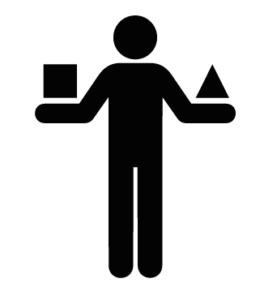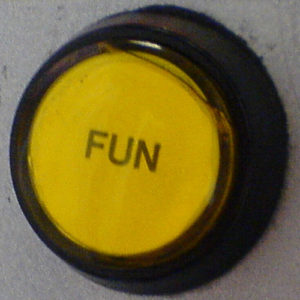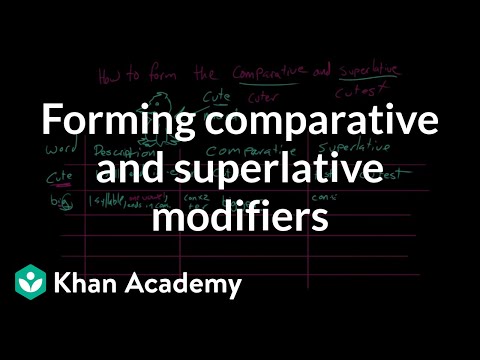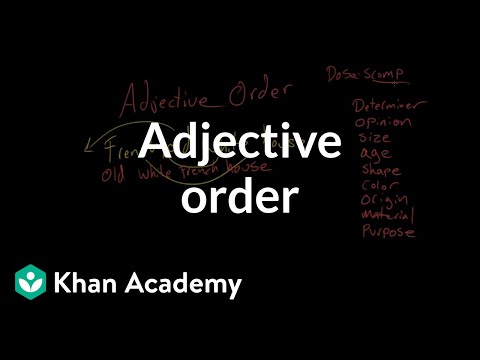8.19: Text: Adjectives
- Page ID
- 59485
 An adjective modifies a noun; that is, it provides more detail about a noun. This can be anything from color to size to temperature to personality. Adjectives usually occur just before the nouns they modify. In the following examples, adjectives are in bold, while the nouns they modify are in italics (the big bear):
An adjective modifies a noun; that is, it provides more detail about a noun. This can be anything from color to size to temperature to personality. Adjectives usually occur just before the nouns they modify. In the following examples, adjectives are in bold, while the nouns they modify are in italics (the big bear):
- The generator is used to convert mechanicalenergy into electricalenergy.
- The steelpipes contain a protective sacrificialanode and are surrounded by packingmaterial.
Adjectives can also follow a linking verb. In these instances, adjectives can modify pronouns as well. In the following examples, adjectives are still bold, while the linking verb is in italics this time (the sun isyellow):
- The schoolhouse wasred.
- I lookedgood today.
- She wasfunny.
Numbers can also be adjectives in some cases. When you say “Seven is my lucky number,” seven is a noun, but when you say “There are seven cats in this painting,” seven is an adjective because it is modifying the noun cats.
Practice
Identify the adjectives in the following sentences:
- Of the four seasons, fall is my favorite; I love the red leaves, the cool weather, and the brisk wind.
- My roommate, on the other hand, thinks that summer is the best season.
- I think she is crazy.
- Fall is better than summer. Summer is too hot and muggy to be enjoyable.
[reveal-answer q=”383934″]Show Answer[/reveal-answer]
[hidden-answer a=”383934″]
The adjectives have been bolded in the sentences below:
- Of the four seasons, fall is my favorite; I love the red leaves, the cool weather, and the brisk wind.
- My roommate, on the other hand, thinks that summer is the best season.
- I think she is crazy.
- Fall is better than summer. Summer is too hot and muggy to be enjoyable. (All of these adjectives follow linking verbs.)
[/hidden-answer]
Comparable Adjectives
 Some adjectives are comparable. For example, a person may be polite, but another person may be more polite, and a third person may be the most polite of the three. The word more here modifies the adjective polite to indicate a comparison is being made (a comparative), and most modifies the adjective to indicate an absolute comparison (a superlative).
Some adjectives are comparable. For example, a person may be polite, but another person may be more polite, and a third person may be the most polite of the three. The word more here modifies the adjective polite to indicate a comparison is being made (a comparative), and most modifies the adjective to indicate an absolute comparison (a superlative).
There is another way to compare adjectives in English. Many adjectives can take the suffixes –er and –est (sometimes requiring additional letters before the suffix; see forms for far below) to indicate the comparative and superlative forms, respectively:
- great, greater, greatest
- deep, deeper, deepest
- far, farther, farthest
Some adjectives are irregular in this sense:
- good, better, best
- bad, worse, worst
- little, less, least
Another way to convey comparison is by incorporating the words more and most. There is no simple rule to decide which means is correct for any given adjective, however. The general tendency is for shorter adjectives to take the suffixes, while longer adjectives do not—but sometimes sound of the word is the deciding factor.
more beautiful not beautifuller
more pretentious not pretentiouser
While there is no perfect rule to determine which adjectives will or won’t take –er and –est suffixes, this video lays out some “sound rules” that can serve as helpful guidelines:
A Note about Fun
 The adjective fun is one of the most notable exceptions to the rules. If you follow the sound rules we just learned about, the comparative should be funner and the superlative funnest. However, for a long time, these words were considered non-standard, with more fun and most fun acting as the correct forms.
The adjective fun is one of the most notable exceptions to the rules. If you follow the sound rules we just learned about, the comparative should be funner and the superlative funnest. However, for a long time, these words were considered non-standard, with more fun and most fun acting as the correct forms.
The reasoning behind this rule is now obsolete (it has a lot to do with the way fun became an adjective), but the stigma against funner and funnest remains. While the tides are beginning to change, it’s safest to stick to more fun and most fun in formal situations (such as in academic writing or in professional correspondence).
Non-Comparable Adjectives
Many adjectives do not naturally lend themselves to comparison. For example, some English speakers would argue that it does not make sense to say that one thing is “more ultimate” than another, or that something is “most ultimate,” since the word ultimate is already an absolute. Such adjectives are called non-comparable adjectives. Other examples include dead, true, and unique.
Native speakers will frequently play with non-comparable adjectives. Although pregnant is logically non-comparable (someone is pregnant or she is not), you may hear a sentence like “She looks more and more pregnant each day.” Likewise extinct and equal appear to be non-comparable, but one might say that a language about which nothing is known is “more extinct” than a well-documented language with surviving literature but no speakers, and George Orwell once wrote “All animals are equal, but some are more equal than others.”
Practice
Read the following passage. Identify the adjectives, and categorize them by comparable and non-comparable.
The Principality of Sealand has been described as the world’s smallest nation. However, it is more accurate to describe it as an unrecognized micronation. It claims Roughs Tower, an offshore platform located approximately 7.5 miles off the coast of Suffolk, England, as its territory. Roughs Tower is a disused Maunsell Sea Fort, originally called HM Fort Roughs, built as an anti-aircraft defensive gun platform by the British during World War II.
Since 1967, the decommissioned HM Fort Roughs has been occupied by family and associates of Paddy Roy Bates, who claim that it is an independent sovereign state. However, Sealand is not officially recognized by any established sovereign state. Bates moved to the mainland when he became elderly, naming his son Michael regent.
[practice-area rows=”4″][/practice-area]
[reveal-answer q=”814015″]Show Answer[/reveal-answer]
[hidden-answer a=”814015″]
The adjectives are smallest, accurate, unrecognized, Roughs, offshore, Roughs, disused, Maunsell Sea, anti-aircraft, defensive, gun, decommissioned, independent, sovereign, recognized, established, sovereign, elderly
Here’s the passage again with all the adjectives bolded:
The Principality of Sealand has been described as the world’s smallest nation. However, it is more accurate to describe it as an unrecognized micronation. It claims Roughs Tower, an offshore platform located approximately 7.5 miles off the coast of Suffolk, England, as its territory. Roughs Tower is a disused Maunsell Sea Fort, originally called HM Fort Roughs, built as an anti-aircraft defensive gun platform by the British during World War II.
Since 1967, the decommissioned HM Fort Roughs has been occupied by family and associates of Paddy Roy Bates, who claim that it is an independent sovereign state. However, Sealand is not officially recognized by any established sovereign state. Bates moved to the mainland when he became elderly, naming his son Michael regent.
The comparable adjectives are smallest, accurate, unrecognized, offshore, disused, defensive, independent, recognized, established, and elderly.
The non-comparable adjectives are Roughs, Maunsell Sea, anti-aircraft, gun, decommissioned, and sovereign. As you can see, several of these non-comparable adjectives are places or things that have acted as adjectives in this passage (like Maunsell Sea and gun).
[/hidden-answer]
Now that you’ve identified the comparable adjectives, write their comparative and superlative forms in the text frame below:
[practice-area rows=”4″][/practice-area]
[reveal-answer q=”814016″]Show Answer[/reveal-answer]
[hidden-answer a=”814016″]
| Adjective | Comparative | Superlative |
|---|---|---|
| small | smaller | smallest |
| accurate | more accurate | most accurate |
| unrecognized | more unrecognized | most unrecognized |
| offshore | more offshore | most offshore |
| disused | more disused | most disused |
| defensive | more defensive | most defensive |
| independent | more independent | most independent |
| recognized | more recognized | most recognized |
| established | more established | most established |
| elderly | more elderly | most elderly |
[/hidden-answer]
Adjective Order
If you’re a native English speaker, you may have noticed that “the big red house” sounds more natural than “the red big house.” The video below explains the order in which adjectives occur in English:
Practice
Read the following sentences. Are the adjectives in the correct order? Type any corrections in the text frame below:
- Ramin was throwing a party out at his ancient stone big house.
- Can you believe James lost his leather dumb Italian wallet?
- Sofía was transfixed by that green big singing fish.
- He bought a pink new nice bouquet of flowers.
[practice-area rows=”4″][/practice-area]
[reveal-answer q=”415266″]Show Answer[/reveal-answer]
[hidden-answer a=”415266″]
- Ancient describes age, stone describes material, and big describes size. The correct order would be size, age, material:
- Ramin was throwing a party out at his big ancient stone house.
- Leather describes material, dumb describes opinion, and Italian describes origin. The correct order would be opinion, origin, material:
- Can you believe James lost his dumb Italian leather wallet?
- Green describes color, big describes size, and singing describes purpose. The correct order would be size, color, purpose:
- Sofía was transfixed by that big green singing fish.
- Pink describes color, new describes age, nice describes opinion. The correct order would be opinion, age, color:
- He bought a nice new pink bouquet of flowers.
[/hidden-answer]
- Revision and Adaptation. Provided by: Lumen Learning. License: CC BY-SA: Attribution-ShareAlike
- Practice Exercises. Provided by: Lumen Learning. License: CC BY: Attribution
- Basic Patterns and Elements of the Sentence. Authored by: David McMurrey. Located at: https://www.prismnet.com/~hcexres/textbook/twsent.html#adj. License: CC BY: Attribution
- Adjective. Provided by: Wikipedia. Located at: https://en.wikipedia.org/wiki/Adjective. License: CC BY-SA: Attribution-ShareAlike
- Forming comparative and superlative modifiers. Authored by: David Rheinstrom. Provided by: Khan Academy. Located at: https://www.khanacademy.org/humanities/grammar/partsofspeech/the-modifier/v/forming-the-comparative-and-superlative. License: CC BY-NC-SA: Attribution-NonCommercial-ShareAlike
- Image with square and triangle. Authored by: Anna Vital. Provided by: The Noun Project. Located at: https://thenounproject.com/search/?q=size&i=25765. License: CC BY: Attribution
- Image of Russian nesting dolls. Authored by: Dima Lagunov. Provided by: The Noun Project. Located at: https://thenounproject.com/search/?q=difference&i=433002. License: CC BY: Attribution
- Adjective order. Authored by: David Rheinstrom. Provided by: Khan Academy. Located at: https://www.khanacademy.org/humanities/grammar/partsofspeech/the-modifier/v/adjective-order. License: CC BY-NC-SA: Attribution-NonCommercial-ShareAlike
- Principality of Sealand. Provided by: Wikipedia. Located at: https://en.wikipedia.org/wiki/Principality_of_Sealand. License: CC BY-SA: Attribution-ShareAlike
- Image of fun. Authored by: Tom Hodgkinson. Located at: https://flic.kr/p/FLokX. License: CC BY-SA: Attribution-ShareAlike



